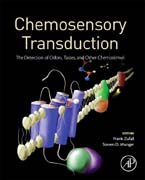
Chemosensory Transduction: The Detection of Odors, Tastes, and Other Chemostimuli
Zufall, Frank
Munger, Steven D.
Written by leaders in the field of chemosensation, Chemosensory Transduction provides a comprehensive resource for understanding the molecular mechanisms that allow animals to detect their chemical world. The text focuses on mammals, but also includes several chapters on chemosensory transduction mechanisms in lower vertebrates and insects. This book examines transduction mechanisms in the olfactory, taste, and somatosensory (chemesthetic) systems as well as in a variety of internal sensors that are responsible for homeostatic regulation of the body. Chapters cover such topics as social odors in mammals, vertebrate and invertebrate olfactory receptors, peptide signaling in taste and gut nutrient sensing. Includes a foreword by preeminent olfactory scientist Stuart Firestein, Chair of Columbia University's Department of Biological Sciences in New York, NY. Chemosensory Transduction describes state-of-the-art approaches and key findings related to the study of the chemical senses. Thus, it serves as the go-to reference for this subject for practicing scientists and students with backgrounds in sensory biology and/or neurobiology. The volume will also be valuable for industry researchers engaged in the design or testing of flavors, fragrances, foods and/or pharmaceuticals. Provides a comprehensive overview for all chemosensory transduction mechanismsValuable for academics focused on sensory biology, neurobiology, and chemosensory transduction, as well as industry researchers in new flavor, fragrance, and food testingEdited by leading experts in the field of olfactory transductionFocuses on mammals, but lower vertebrates and invertebrate model systems are also included INDICE: Introduction and Overview - Frank Zufall and Steven D. Munger Section I. Chemostimuli 1. Specialized chemosignaling that generates social and survival behavior in mammals - Lisa Stowers and Tsung-Han Kuo 2. Chemical ecology in insects - Bill Hansson and Dieter Wicher Section II. Olfaction 3. Vertebrate ORs - Kazushige Touhara, Yoshihito Niimura and Sayoko Ihara 4. Odor sensing by trace amine-associated receptors - Qian Li and Stephen D. Liberles 5. Aquatic olfaction - Sigrun Korsching 6. Insect Olfactory Receptors: An Interface Between Chemistry and Biology - Gregory M. Pask and Anandasankar Ray 7. Cyclic AMP Signaling in the Main Olfactory Epithelium - Christopher H. Ferguson and Haiqing Zhao 8. cGMP signaling in olfactory sensory neurons - Trese Leinders-Zufall and Pablo Chamero 9. Ciliary trafficking of transduction molecules - Jeffrey Martens 10. Vomeronasal receptors: V1Rs, V2Rs and FPRs - Ivan Rodriguez 11. Vomeronasal transduction and cell signaling - Marc Spehr 12. Comparative olfactory transduction - Elizabeth A. Corey and Barry Ache Section III. Taste 13. G protein-coupled taste receptors - Maik Behrens and Wolfgang Meyerhof 14. Mechanism of Taste Perception in Drosophila - Hubert Amrein 15. G protein-coupled taste transduction - Sue C. Kinnamon 16. The mechanisms of salty and sour taste - Steven D. Munger 17. Peptide signaling in taste transduction - Shingo Takai, Ryusuke Yoshida, Noriatsu Shigemura and Yuzo Ninomiya Section IV. Other Chemodetection Systems 18. O2 and CO2 Detection by the Carotid and Aortic bodies - Nanduri R. Prabhakar 19. Chemosensation in the ventricles of the central nervous system - Mari Aoki and Ulrich Boehm 20. Gut nutrient sensing - Sami Damak 21. Chemesthesis - Jay P. Slack
- ISBN: 978-0-12-801694-7
- Editorial: Academic Press
- Encuadernacion: Cartoné
- Páginas: 410
- Fecha Publicación: 01/04/2016
- Nº Volúmenes: 1
- Idioma: Inglés
